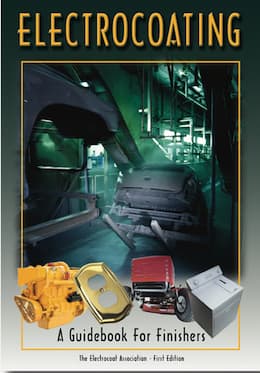
Curated with aloha by
Ted Mooney, P.E. RET

The authoritative public forum
for Metal Finishing 1989-2025

-----
Cathodic Electrodeposition (CED) General Questions and Theory
Q. Please advise the Ampere and voltage needed for this e-coating rectifier.
It is for truck body 3.66 x 1.85 x 1.84 m
Total surface area for coating about 61 SqM.
Thanks.
- singapore singapore
March 10, 2021
⇩ Related postings, oldest first ⇩
2003
Q. Hi,
I have been working on the project "Electrodeposition of organofunctional silanes on metals". Silanes are organic-inorganic hybrid compounds used for protecting metals from corrosion. I have been doing cathodic deposition and got extremely nice and uniform coating as compared to a normal dip coating. However, my process doesn't give good reproducibility sometimes. The coating solution consists of Si-OH groups that are supposed to interact with OH- ions at the cathode during water decomposition, when H2 is released and form Me-O-Si bonds where Me is the metal usually present as a metal hydroxide
Me-OH + Si-OH = Me-O-Si + H2O
I shall highly appreciate if you please answer few of my questions.
1. I have observed that paint cathodic electrodeposition involves application of very high voltages up to 250 V. At this high voltage rigorous hydrogen formation will occur as it far exceeds the break potential of water. What is the effect of excessive hydrogen formation on the coating. Are they porous?
2. What should be the ideal pH of the solution for cathodic electrocoating? I keep it at 4.
3. I use maximum of 10 V and obtain current up to 20 mA. Do I need to increase the voltage or current but as the voltage or current increases rigorous hydrogen evolution takes place at the cathode and I believe it may be fatal for deposition.
4. How can we figure out how much voltage or current is required for our deposition process.
Thank You,
Graduate Research Assistant - Cincinnati, Ohio, USA
A. The rectifier capacity calculations will give the requirement of current , it requires the Thickness of coating required, paint density,paint coloumbic yield, total tank capacity, etc.
The pH of the CED is in between 6.5-8.5
- Thane, Mumbai, Maharashtra, India
2007
A. Your first answer------ the coating is like rough coating & Once you just wipe it by smooth hands you will observe the pin holes. the solution of the problem is you have to check the ripples of the rectifier.
Second one ------- The pH of the CED bath is always up to 5.5 to
6.3
Third one ------- the voltage and the current depend on the Surface area of the product & Coating thickness.
- Dahod, Gujarat
January 29, 2009
Sizing a rectifier for CED Coating
I NEED TO START CED COATING PROCESS IN MY LABORATORY. WHAT CAPACITY OF RECTIFIER, i.e., VOLTAGE AND AMPERE IS REQUIRED FOR 20 LIT CAPACITY PAINT BATH. SURFACE AREA OF THE SAMPLES WILL BE AROUND 4-5 SQ FT.
DR. DIPANKAR SENRESEARCH & DEVELOPMENT- PLATING SHOP - KOLKATA, India
October 7, 2010
by Electrocoat Association

on eBay or
AbeBooks
or Amazon
(affil links)
Q. Dear All,
Please tell me calculations of CED coating
1) How to decide Voltage and Ampere of rectifier
2) How to calculate chiller capacity for CED bath
3) How to calculate anode specifications with qty to decide
Please reply it's urgent.
Surface coating industry - Pune, Maharashtra, India
February 1, 2016
A. Hi cousin Yogesh. If your situation truly is urgent please immediately retain a CED consultant. Please remember that this is merely a public forum, where knowledgable readers come and go on their own schedules, not on my or your sense of urgency :-)
Further, nobody can possibly learn enough about the subject overnight to be able to properly specify things. But maybe if you detail the type and size of parts, the kind of coating polymer, salt spray or other testing requirements, and your required production rate, readers may be able to get you started. Also, while you're waiting, note that we have a dozen or more long and educational threads about CED coating (use the search engine), and there are at least two good books on the subject.
Best of luck.
Regards,

Ted Mooney, P.E.
Striving to live Aloha
finishing.com - Pine Beach, New Jersey
March 2016
Q, A, or Comment on THIS thread -or- Start a NEW Thread